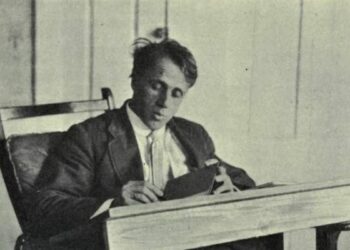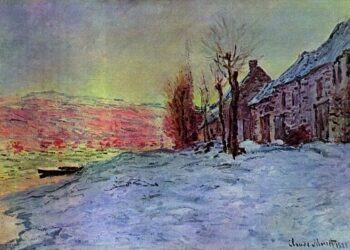Table of Contents
ToggleA Barred Owl Poem Summary by Richard Wilbur
Richard Wilbur’s “A Barred Owl” is a lyrical exploration of the intersection between the natural world and the delicate realm of human perception. This enchanting poem, with its evocative language and vivid imagery, invites readers into the intimate confines of a darkened room, where the ordinary becomes extraordinary through the lens of a child’s response to the haunting call of a barred owl.
Wilbur deftly crafts a story that reveals the nuanced depths of human emotion, innocence, and the enigmatic beauty of the nighttime landscape as the night air warps and the owl’s voice reverberates around the space. The poem develops as a subtle conversation between an adult’s consoling words and a child’s profound, spiritual response to the owl’s inquiry.
Also Read-
The Under Graham Railroad Box Car Set Summary, Characters and Themes
The Things They Carried ,Summary,Characters and Themes
The Tell-Tale Heart Introduction, Characters and Themes
Through rhythmic repetition and a keen sensitivity to the sensory details of the scene, Wilbur captures the essence of a fleeting moment, transcending the mundane to explore the profound connection between the external environment and the internal world of the human psyche
A Barred Owl Poem Summary
- “The warping night air having brought the boom” The poem opens with a description of the night air, using the word “warping” to suggest a distortion or change in the atmosphere. The “boom” introduces a sudden and potentially ominous sound.
- “Of an owl’s voice into her darkened room,” The cause of the boom is revealed to be the voice of an owl, which has entered a darkened room. This sets the stage for the poem’s exploration of the impact of natural sounds on human perception.
- “We tell the wakened child that all she heard” The collective “we” implies a communal response, suggesting a shared responsibility to address the disturbance caused by the owl’s call. The child has been awakened, prompting the adults to intervene.
- “Was an odd question from a forest bird,” The adults attempt to rationalize the owl’s call to the child, framing it as a peculiar question from a bird in the forest. This introduces a theme of human tendency to normalize or explain the unknown.
- “Asking of us, if rightly listened to,” The suggestion here is that the owl’s question requires careful and attentive listening. This emphasizes the importance of perception and interpretation in understanding the natural world.
- “Who cooks for you? who cooks for you?” The actual question posed by the owl is revealed, repeating a melodic pattern that mimics the bird’s call. The repetition adds a rhythmic and almost humorous quality to the poem.
- “And then a pale, straight line of light,” The narrative shifts to a visual element, describing a pale, straight line of light. This could be the result of a curtain or blind allowing a sliver of light into the dark room, adding a visual layer to the sensory experience.
- “Sometimes a piece of her white gown!” The source of the light is identified as a piece of a child’s white gown. This brings attention to the child, possibly symbolizing innocence or vulnerability in the context of the owl’s call.
- “And so, the whole three notes complete,” The completion of the three notes in the owl’s call is highlighted, drawing attention to the musicality of the bird’s communication. This repetition also reinforces the significance of the question.
- “And ‘God’ she says softly. ‘God.'” The child’s response to the owl’s call is introduced, with the utterance of “God” conveying a spiritual or emotional impact. The repetition of the word emphasizes the child’s attempt to grasp the profundity of the experience.
- “The word was not profane, but moved,” The speaker clarifies that the child’s use of the word “God” is not intended as profanity. Instead, it is a genuine and emotionally charged response that has stirred something within her.
- “The air, the fleshy curtains moved:” The surroundings react to the child’s emotional response. The movement of the air and curtains suggests a ripple effect, as if the owl’s call has set in motion a subtle transformation in the room.
- “The little boy, still moving under sleep,” Another character, a little boy, is introduced. He is described as moving under sleep, hinting at a potentially disturbed or restless slumber.
- “Was now for the first time dreaming of light.” The owl’s call seems to have influenced the little boy’s dream, awakening a new awareness or dream of light. This introduces a theme of illumination or enlightenment connected to the owl’s presence.
- “The fiery girl, flushed from the clear dream,” A fiery girl is described as flushed, suggesting intense emotion. Her dream is contrasted with the little boy’s, characterized as clear. This highlights the subjective and varied nature of individual responses to the owl’s call.
- “Nowheres but looks through bars of darkened glass” The word “Nowheres” adds a sense of disorientation or lack of direction. The girl’s vision is limited to looking through bars of darkened glass, creating a metaphorical barrier that adds a layer of confinement or restriction.
- “To three nocturnal notes, three seals of light,” The three nocturnal notes refer back to the owl’s call. The mention of “three seals of light” adds a mystical or symbolic quality, as if the owl’s call has marked the scene with an otherworldly significance.
- “And hears around her bed the awful press” The girl perceives a surrounding presence, described as an “awful press.” This term implies a weight or intensity in the atmosphere, possibly influenced by the owl’s call. The use of “press” adds a sense of immediacy and impact.
- “Of the dark questioning source, the night-long sound” The source of the questioning sound is labeled as “dark,” emphasizing its mysterious and enigmatic nature. The phrase “night-long sound” reinforces the ongoing and persistent quality of the owl’s call.
- “There is the voice which is the sound of all.” The poem concludes with a statement about the owl’s voice being the “sound of all.” This suggests a universal or encompassing quality to the owl’s call, connecting it to the larger context of existence or the natural world.

Conclusion
“A Barred Owl” by Richard Wilbur intricately weaves a narrative exploring the intersection of the natural world with the human experience, particularly the impact of an owl’s call on a child’s perception. Through vivid imagery and nuanced language, the poem delves into themes of innocence, the mystery of nature, and the complex emotions elicited by unexpected sounds in the night.
The poem deftly handles parents’ initial attempt to dismiss the owl’s call as a query from a harmless forest bird. But it also deftly illustrates the deep impact this nighttime noise has on the youngster, as she replies, “God.” A multi-layered investigation of human susceptibility and the connections between the natural and emotional domains is produced by the description of the children’s dreams that follows, as well as the changes in the room’s atmosphere.
Wilbur employs rhythmic repetition in the owl’s call, contributing to the poem’s musicality and emphasizing the cyclical nature of nature’s sounds. The shift from a seemingly ordinary explanation to the child’s spiritual response adds depth, inviting readers to contemplate the power of perception and the intimate connection between the external environment and internal emotions.
In essence, “A Barred Owl” serves as a poetic exploration of the delicate balance between the familiar and the unknown, the natural and the supernatural, within the intimate confines of a darkened room.
FAQ:
Who is the speaker in “A Barred Owl”?
The speaker is not explicitly identified in the poem. However, it can be inferred that the speaker is an adult figure, possibly a parent or caregiver, addressing a child who has been disturbed by the sound of an owl.
What is the significance of the child’s response, saying “God”?
The child’s utterance of “God” suggests a profound and emotional response to the owl’s call. It highlights the child’s innocence and vulnerability, as well as the mysterious and awe-inspiring nature of the natural world.
How does Wilbur use repetition in the poem?
Repetition is employed in the rhythmic pattern of the owl’s call, “Who cooks for you? who cooks for you?” This repetition not only mimics the actual sound of an owl but also adds a musical quality to the poem, emphasizing the cyclical and persistent nature of nature’s sounds.
What is the significance of the visual elements in the poem, such as the pale line of light and the piece of the child’s gown?
The visual elements contribute to the sensory richness of the poem. The pale line of light and the piece of the child’s gown serve as tangible details that enhance the reader’s engagement with the scene, adding visual and tactile dimensions to the emotional impact of the owl’s call.
How does “A Barred Owl” explore the theme of innocence?
The theme of innocence is evident in the child’s response to the owl’s call. The child’s use of the word “God” and the descriptions of the children’s dreams emphasize their vulnerability and the purity of their emotional reactions to the natural world.
What is the overall mood or atmosphere of the poem?
The mood of the poem shifts from a lighthearted attempt to explain the owl’s call to a more profound and contemplative atmosphere. The nighttime setting, the owl’s call, and the emotional responses of the characters contribute to an atmosphere that is both mysterious and introspective.

















